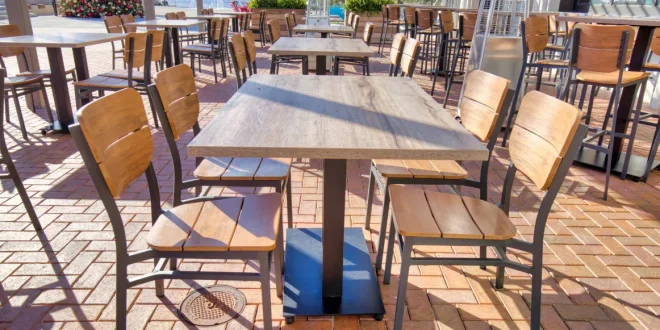Outdoor dining has grown in popularity, with restaurants and cafes expanding their spaces to include patios, terraces, and gardens. To create an inviting and functional outdoor dining experience, choosing the right outdoor restaurant furniture is essential. This furniture must not only be stylish and comfortable but also durable enough to withstand changing weather conditions.
In this article, we’ll explore the key aspects of outdoor restaurant furniture, from material choices and design options to durability considerations and how to choose the perfect pieces to enhance your restaurant’s outdoor dining area.
1. The Importance of Outdoor Restaurant Furniture
A well-designed outdoor seating area can significantly boost a restaurant’s appeal, offering customers a relaxing space to enjoy their meals in a fresh, open-air setting. The right furniture plays a crucial role in creating a welcoming atmosphere and ensuring customer comfort.
A. Aesthetic Appeal and Ambiance
The first impression of your outdoor dining area is largely shaped by its furniture. The furniture sets the tone for the overall ambiance, whether you want a rustic, modern, or coastal theme. Stylish outdoor restaurant furniture can attract more customers by creating a pleasant dining experience, blending seamlessly with the environment and your restaurant’s theme.
B. Functionality and Comfort
While the visual appeal of outdoor furniture is important, functionality and comfort are critical for customer satisfaction. Comfortable seating with ergonomic designs encourages customers to stay longer and return for future visits. Outdoor restaurant furniture should provide ample seating space, sturdy tables, and comfortable chairs or benches that make customers feel at ease.
C. Weather Resistance and Durability
Unlike indoor furniture, outdoor restaurant furniture is constantly exposed to the elements, including rain, sun, wind, and temperature fluctuations. As such, it must be made from durable, weather-resistant materials that can handle these conditions without compromising on appearance or structural integrity.
2. Materials for Outdoor Restaurant Furniture
When selecting outdoor furniture for a restaurant, the choice of materials is one of the most important factors to consider. Different materials offer varying levels of durability, maintenance, and aesthetic appeal. Here are some of the most common materials used for outdoor restaurant furniture:
A. Aluminum
Aluminum is a popular choice for outdoor furniture due to its lightweight, rust-resistant, and low-maintenance properties. It’s ideal for restaurants that frequently move or rearrange their furniture, as it is easy to handle and can withstand exposure to moisture without corroding.
- Powder-coated finishes: Aluminum furniture is often coated with a powder finish to protect it from scratches, chips, and fading caused by UV exposure, making it a durable and stylish option for outdoor spaces.
B. Teak Wood
Teak wood is one of the most durable and premium materials used for outdoor furniture. Known for its natural resistance to moisture, insects, and decay, teak is a great choice for restaurants in climates with heavy rain or humidity.
- Weathered patina: Over time, teak develops a beautiful silvery-gray patina, adding to its charm. However, it can also be maintained with oil treatments to preserve its original golden hue.
- Durability: Teak is naturally resistant to warping and cracking, making it an excellent option for long-term outdoor use.
C. Wicker and Rattan
Wicker and rattan are frequently used for outdoor seating, offering a light and airy look that works well in casual and coastal-themed restaurants. Modern outdoor wicker is typically made from synthetic materials like resin or HDPE (high-density polyethylene), which offer better durability and weather resistance than natural wicker.
- UV resistance: Synthetic wicker is resistant to fading caused by sunlight, making it a great choice for outdoor seating areas exposed to the sun for extended periods.
- Comfort and style: Wicker furniture often comes with plush cushions that enhance comfort, while the woven design adds texture and style to outdoor spaces.
D. Stainless Steel
For a sleek, modern aesthetic, stainless steel furniture is a popular option. Stainless steel is highly resistant to corrosion and rust, making it suitable for outdoor restaurant furniture, especially in urban or coastal environments.
- Durability: Stainless steel is incredibly strong and can withstand heavy use in busy restaurants. It’s also easy to clean and maintain, requiring only occasional polishing to remove fingerprints or smudges.
- Versatility: Stainless steel furniture often pairs well with glass, wood, or concrete tabletops, offering a modern, industrial look.
E. Plastic and Resin
Plastic and resin furniture are affordable, low-maintenance options for outdoor dining. These materials are highly resistant to weather, fading, and cracking, making them suitable for casual dining spaces.
- Lightweight and portable: Plastic furniture is easy to move and rearrange, making it ideal for restaurants that frequently change their seating arrangements or need to store furniture during off-seasons.
- Wide range of colors: Plastic and resin furniture are available in a wide variety of colors and designs, offering plenty of flexibility for creating vibrant outdoor dining areas.
3. Design Considerations for Outdoor Restaurant Furniture
When choosing outdoor restaurant furniture, design considerations should include not only aesthetics but also the practical needs of the restaurant. The layout of your space, the type of dining experience you want to offer, and the comfort of your guests should guide your design choices.
A. Space Optimization
Outdoor spaces can vary in size and shape, so it’s essential to choose furniture that fits the available area without overcrowding it. For smaller patios, compact tables and stackable chairs can help maximize space while maintaining a comfortable layout.
- Flexible seating arrangements: Consider modular furniture that can be rearranged to accommodate groups of different sizes. Benches or communal tables are excellent options for outdoor dining areas that need to seat both small and large parties.
B. Comfort and Ergonomics
Comfort is key in outdoor dining areas. Look for chairs with ergonomic designs that offer back support and cushions that add comfort without compromising on style. Many outdoor chairs now feature weather-resistant cushions that are easy to clean and maintain.
- Upholstery materials: Cushions and upholstery should be made from fabrics like Sunbrella, which is resistant to UV rays, moisture, and stains. These fabrics retain their color and texture even after prolonged exposure to the elements.
C. Style and Aesthetic
The style of your outdoor furniture should complement the overall theme of your restaurant. For example, a rustic restaurant might opt for wooden tables and chairs, while a modern cafe could choose sleek metal or glass-top tables. Whether you want a casual, laid-back vibe or a more formal, upscale look, your furniture should reflect the atmosphere you aim to create.
- Coordinating colors and textures: Choosing a cohesive color palette and coordinating materials, such as matching table tops and chair frames, will help create a unified and polished look in your outdoor dining area.
D. Durability and Maintenance
Outdoor restaurant furniture should be durable enough to handle constant use, varying weather conditions, and regular cleaning. Choose materials that require minimal maintenance, as this will save time and effort in the long run.
- Easy-to-clean surfaces: Opt for furniture that can be easily wiped down and cleaned between uses. For instance, metal and plastic furniture can be cleaned with a damp cloth, while wood may require occasional sealing or staining to protect it from the elements.
4. Choosing the Right Outdoor Restaurant Furniture Supplier
Selecting a reliable supplier for outdoor restaurant furniture is essential for ensuring high-quality, durable products that meet your restaurant’s specific needs. When choosing a supplier, consider the following factors:
A. Quality of Materials
Ensure that the supplier uses high-quality, weather-resistant materials in the construction of their furniture. This will ensure the longevity of your investment and reduce the need for frequent replacements.
B. Customization Options
A good supplier will offer a variety of customization options, allowing you to choose the size, color, and design of the furniture to suit your restaurant’s style. Some suppliers also offer bespoke services, creating custom pieces that are unique to your brand.
C. Warranty and After-Sales Support
Look for suppliers that offer warranties on their outdoor furniture, especially for high-traffic areas where wear and tear are inevitable. Additionally, a supplier with good after-sales support can assist with repairs or replacements if needed.
5. Conclusion
Investing in the right outdoor restaurant furniture is essential for creating an inviting and comfortable outdoor dining space. From selecting durable, weather-resistant materials like teak wood, aluminum, and stainless steel to choosing furniture that complements your restaurant’s style and layout, each decision plays a crucial role in enhancing the customer experience. By focusing on aesthetics, functionality, and durability, you can create an outdoor seating area that not only looks great but also stands the test of time.
 Diverse Perspectives: Insights & Stories Exploring Ideas, Sharing Knowledge
Diverse Perspectives: Insights & Stories Exploring Ideas, Sharing Knowledge





